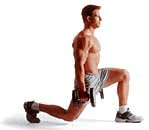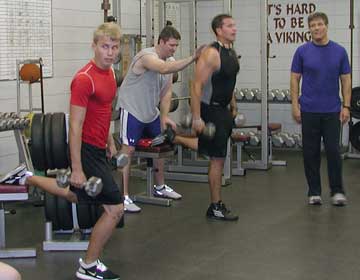|
My VERY Favorite Leg Exercise
 Rather than starting this article off with a riddle (like what's black and white and red all over?... a newspaper), I've decided to the take the suspense completely out of it!
Rather than starting this article off with a riddle (like what's black and white and red all over?... a newspaper), I've decided to the take the suspense completely out of it!
My VERY favorite leg exercise for really hitting the thighs HARD is not a new exercise...it may not even seem to you to be all that great of an exercise at first glance. But when I tell you how to do it FOR REAL, you're going to LOVE the results you get with it.
The exercise is the Dumbell Split Squat and it's going to change the way you look at dumbell leg exercises forever!
Here's what it is:
To honest, it looks almost exactly like an incomplete dumbell lunge. In fact, you may have even done it before thinking it WAS a dumbell lunge.
The big difference is this...when you do a regular dumbell lunge, you start in a standing position holding two dumbells in your hands. You take a step forward with one leg then drop down into a lunge position. From there, you push yourself all the way back up to the standing position then repeat with the other leg (stepping forward then pushing all the way back up).
When you do a Dumbell Split Squat, you START in the split position (which looks like the bottom of the lunge) and STAY there. You just move your body up and down, keeping your feet exactly where they are on the floor. No standing up, no stepping forward.
This is a key difference. It takes away many of the balance problems you find with lunges...it also takes away almost ALL of the knee stress that you might experience with lunges (when you step forward, your knee has to absorb all the momentum of not only your body but the weight of the dumbells moving forward).
 When you plant your feet, you can keep your balance MUCH better. When you don't step forward, your knees don't take that stress from the forward momentum.
When you plant your feet, you can keep your balance MUCH better. When you don't step forward, your knees don't take that stress from the forward momentum.
The Dumbell Split Squat is also ideal for home workout situations in that you only need a couple of dumbells to get an AMAZING leg workout.
Now, these are some great benefits but do you want to know what REALLY makes this my favorite leg exercise for hitting the thighs hard?
Simple...it gives you the ability to absolutely DESTROY your quads without mercy. It does this by having the resistance very close to the ground at the hardest part of the exercise (the bottom of the rep).
Basically, this means when you're doing the split squat, if you get to the bottom of the rep and can't push yourself back up, your dumbells are only an inch or two from the floor! All you have to do is set them down and you're done.
The practical upshot of this simple feature is that you can perform the exercise until your legs ABSOLUTELY GIVE OUT. When you're doing a barbell squat, you can certainly work your legs extremely hard but it's tough to push them to the absolute limit - you always have to get the bar back to the racks before you're done.
With practice and time, you can build up to some VERY heavy dumbells with this exercise (I've gone as high as 2 x 150 lb dumbells for reps).
This exercise puts less stress on the lower back and will work every major muscle group in your entire lower body. Believe me, you'll feel this one in the morning.
How To Do It:
First, pick two light to moderate weight dumbells the first time you do the exercise. You can definitely work up in weight as you work with the exercise more, though. It's important to learn the technique properly before moving on to more weight.
Set the two dumbells on the ground about 6 inches apart. Set your left foot in between but a little forward of the two dumbells. Now set your right foot back about two feet or so and assume a lunge position, kneeling on your right knee. Your right foot should NOT be directly in line with your left foot. When you place your right foot down, set it a little out to the side.
What this does is increase your base of support and make the exercise more stable and allowing you to generate more power. If you set your right foot directly in line with your left foot, you'll be spending most of the exercise trying not to fall over.
Keep your abs and lower back tight and make sure you keep an arch in your lower back here. Lean forward and reach down and grasp the two dumbells. Bring your torso back to vertical, picking up the dumbells off the ground.
 This is the bottom position of the exercise. Now, push yourself up with your left thigh. Don't stand up to vertical...just straighten that front leg, keeping your front foot planted firmly on the ground.
This is the bottom position of the exercise. Now, push yourself up with your left thigh. Don't stand up to vertical...just straighten that front leg, keeping your front foot planted firmly on the ground.
It's important to keep your upper body VERTICAL as you do this exercise. DO NOT allow your body to lean forward as you do the exercise. Imagine it as a straight up and down movement and that you're sitting back as you do it. This visualization will help keep you from leaning forward.
Be sure you don't utilize a forward and back, lunging type of movement, as may be the tendency if you're used to doing regular lunges. This is very much an up and down type of movement.
Perform your target number of reps with your left leg forward. Push yourself hard! If you have to bail out on the exercise, all you need to do is set the dumbells on the ground at the bottom.
At this point, you can either take a rest period or immediately switch to the other leg in front - I prefer to go right to the other leg in front with no break. Do as many reps as you can with the other leg now.
Note that you most likely will not get as many reps with the other leg...no matter which leg is in front, the rear leg is also doing a lot of work. So if you start with the left leg in front, the right leg is still doing work. When you switch legs, the right leg will already be tired from the previous set.
Because of this, it's important to always switch which leg you start with on successive sets. Start with your left foot forward on your first set, then on your next set, start with your right foot forward. This will ensure a balanced workload.
This exercise allows you to basically "leave it on the floor." Because you can just set the dumbells on the floor, you can push your legs to the point where they can hardly keep you standing. That's my idea of a good leg workout!

More Articles by Author Nick Nilsson
Return To Weight Lifting Articles Archive
|